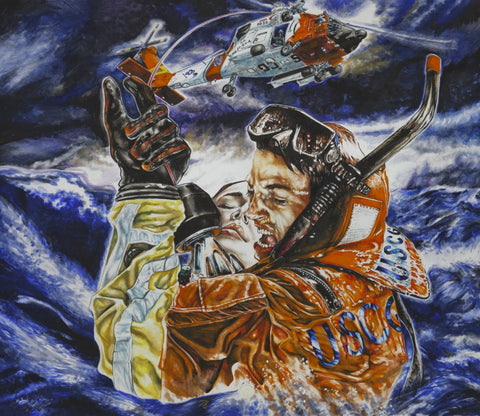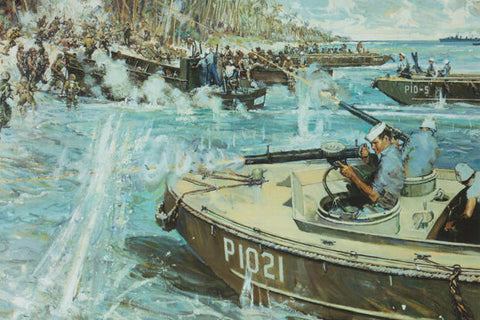Happy 82nd Birthday to the Coast Guard Reserves

On Feb. 19 the U.S. Coast Guard Reserve celebrates its birthday. While it is important to recognize the Coast Guard Reserve birthday, it is even more important to understand why the Coast Guard Reserve is important to military and maritime operations.
The Coast Guard Reserve is a flexible, responsive operational force that exists to support the Coast Guard roles of maritime homeland security, national defense (domestic and expeditionary), and domestic disaster operations. The U.S. Coast Guard depends on the Reserve force to be always ready to mobilize with critical competencies in boat operations, contingency planning and response, expeditionary warfare, marine safety, port security, law enforcement and mission support.
Reservists obtain and maintain proficiency and readiness through a combination of training and augmentation. By doing so, reserve forces achieve mobilization readiness, while providing increased capacity to the local command.
Coast Guard Reserve History
The Coast Guard Reserve was established by the passage of the Coast Guard Reserve and Auxiliary Act of February 19, 1941 which is why Feb. 19th is recognized as the Coast Guard Reserve birthday. That act also established the Coast Guard Auxiliary under its present name (the Auxiliary had originally been called the Coast Guard Reserve).
The new Coast Guard Reserve was modeled after the Naval Reserve as a military component, composed of two broad classifications: Regular Reservists and Temporary Reservists. Regular Reserve members served on active duty during World War II “for the duration,” while Temporary Reserve members consisted of volunteers and former Auxiliary members whose paid and unpaid services were still needed in a military capacity for coastal patrols and port security work.
On November 23, 1942, Congress enacted Public Law 773 establishing the Women Reserve as a branch of the Coast Guard. Members of this branch became known as SPARs, an acronym drawn from the Service motto, Semper Paratus, Always Ready. More than 92 percent of the 214,000 personnel who served in the Coast Guard during World War II were reservists, with an additional 125,000 personnel serving in the temporary reserve. They served in all Coast Guard mission areas.

Coast Guard Reserve Post-World War II
As we celebrate the Coast Guard Reserve birthday, it is important to note that at the conclusion of World War II, most Reservists were released to inactive duty or discharged. The Women’s Reserve was terminated in July 1947 but reestablished in August 1949. By 1950, funds were earmarked by Congress for the establishment of a paid drilling Reserve in support of the Coast Guard. The first organized Coast Guard Reserve unit was formed in Boston in October 1950, setting the framework of today’s Coast Guard Reserve. The Selected Reserve reached a peak post-WWII strength of 17,815 in 1969, during the Vietnam Conflict.
In the Spring of 1973, the Reserve exercised its first involuntary recall to support flood response operations in the Midwest. Some 134 Reservists were recalled. Between then and 1990, only one other involuntary recall was invoked—for the Mariel Boat Lift exodus from Cuba in 1980. The 1980s also included augmentation of the active component to enforce security zones for space shuttle operations in Florida, logging more than 5,900 person-days from 1981 to date. The Coast Guard Reserve birthday is a day to recall how the decade finished with major reserve augmentation for the massive cleanup operations in Alaska following the Exxon Valdez oil spill where 65 percent of personnel used in that operation came from the reserve.
The 1990s saw a growing demand for the Coast Guard’s unique domestic recall authority. The reserve has provided personnel to the active component to support 12 hurricane and six major flood operations, including Hurricane Floyd in 1999. Late that year, the Coast Guard also received authorization to recall reservists to respond to possible Y2K-related contingencies, but did not do so. Reservists volunteered for the 1999 search-and-recovery efforts following the crashes of a light plane piloted by John F. Kennedy Jr. and Egypt Air 990. During 2000, approximately 1,000 reservists served on active duty in support of Operation Sail. All of these notable events are worthy of reflection as we celebrate the Coast Guard Reserve birthday.
In the Coast Guard’s national defense role, 1,650 reservists, more than 15 percent of the selected reserve, participated in Operations Desert Shield/Storm. Reserve-staffed port security units also participated with the joint community in operation Uphold Democracy in Haiti. As we prepare to celebrate the Coast Guard Reserve birthday, they continue to participate in joint military exercises worldwide.

Sea Partners Program
One unique and highly successful Reserve-sponsored program, Sea Partners, has earned high marks around the country since its inception in 1994. Its primary objective has been to educate communities at large in developing awareness of marine pollution issues and improving compliance with marine environmental protection laws and regulations.
More than 300 Coast Guard reservists have participated in the Sea Partners campaign, in which teams of reservists are assigned to each of the 47 Coast Guard Marine Safety Offices across the country. New members are recruited through on-the-job or formal training at Coast Guard Marine Safety Offices.
Since June 1994, Sea Partners teams have reached more than 2 million individuals in personal contacts and many thousands more through print media, radio and television coverage. They have distributed more than a million pieces of printed literature on various marine pollution topics.
The popular Officer Snook campaign has educated hundreds of thousands of children on marine pollution prevention. Through the Sea Partners program, reservists coordinated numerous beach and shore cleanups around the country in fiscal year 2000. Working relationships have been established with community and local government groups, such as the North Carolina Big Sweep, the Dade County, FL Department of Environmental Resource Management and the Pacific Oil Spill Prevention Education Team. Even though it is the Coast Guard Reserve birthday it seems they are giving the nation gifts and not vice-verse.

The vision of the Coast Guard Reserve remains the same on the Coast Guard Reserve birthday. It is the Coast Guard’s only dedicated surge force and it is a contingency-based workforce, trained locally and deployed globally to meet Coast Guard mission requirements. And on the Coast Guard Reserve birthday the mission of the Coast Guard Reserve will continue to be to provide operationally capable and ready personnel to support Coast Guard surge and mobilization requirements in the Homeland and abroad.







